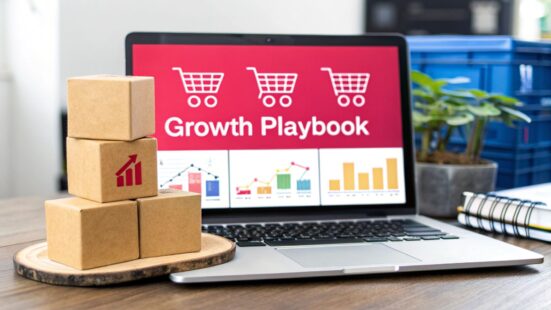 How to Calculate Cost Per Acquisition: A Simple Guide
How to Calculate Cost Per Acquisition: A Simple Guide
An e-commerce growth strategy is your game plan for winning online. It’s the detailed roadmap you build to pull in more revenue, carve out a bigger piece of the market, and create a base of customers who keep coming back. We're talking about a smart mix of marketing, fine-tuning the customer experience, and making sure your operations are running smoothly for the long haul.
Table of Contents
Building a Foundation for Real E-Commerce Growth
If you're still chasing fleeting trends or banking on flash sales to move the needle, you're playing a losing game. A modern e-commerce growth strategy isn't built on short-term tactics; it's about creating sustainable momentum that lasts. It's time to move past just hitting sales targets and start building a rock-solid foundation that lets you scale, even when the market gets crowded.
The world of online retail is exploding. Seriously. Global e-commerce sales are on track to hit a staggering $8.3 trillion by 2025—that's a 55.3% jump from 2021. This boom is fueled by everything from better internet everywhere to the simple fact that everyone shops on their phone now. To get your slice of that pie, a great product isn't enough. You need a proactive framework for growth. If you want to dive deeper into what's next for online payments and the market, the folks at clearlypayments.com have some great insights.
The Three Pillars of Lasting Success
Sitting back and just reacting to what your competitors do is a one-way ticket to stagnation. The brands that win are the ones that build their strategy on three core pillars. These pillars aren't just buzzwords; they should be the bedrock of every single decision you make.
Deep Market Knowledge: This is way more than just a quick peek at what your top three competitors are up to. It’s about genuinely understanding the entire landscape, finding those little untapped niches no one else sees, and getting a feel for where customer behavior is headed before it happens.
Obsessive Customer Focus: Real, sustainable growth is built on retention, not just one-time buyers. This pillar is all about obsessing over every single touchpoint. From the first ad they see to the unboxing experience and the follow-up email, you need to create an experience that turns customers into loyal fans.
Agile Operations: In e-commerce, your ability to adapt on the fly is your secret weapon. This means using data to make smart, quick decisions, bringing in tech that makes you more efficient, and setting up systems that can handle a massive influx of orders without cracking under the pressure.
A solid strategy isn't a dusty document you write once and forget about. It’s a living, breathing framework that guides your daily actions. It tells you where to put your money, what metrics actually matter, and how to pivot intelligently when things change.
Before we dive in, let's quickly summarize these foundational elements.
Table: Core Pillars of a Modern E-Commerce Growth Strategy
Here’s a quick breakdown of the fundamental components you need to build a successful and scalable e-commerce growth plan.
| Pillar | Key Focus | Primary Goal |
|---|---|---|
| Deep Market Knowledge | Competitive analysis, trend forecasting, niche identification | To find and capitalize on market opportunities before competitors do. |
| Obsessive Customer Focus | User experience (UX), customer service, personalization, retention | To build a loyal customer base that drives repeat purchases and referrals. |
| Agile Operations | Data analysis, technology adoption, scalable workflows | To adapt quickly to market changes and scale efficiently without issues. |
Think of these pillars as the legs of a stool—if one is weak, the whole thing becomes unstable.
This guide is your roadmap to putting these principles into action. We’re going to walk through everything from mastering the marketing channels that will actually make you money to using data to scale intelligently. By the end, you'll have a clear plan to turn your online store from a simple shop into a true growth machine.
Truly Understanding Your Market And Audience
Sustainable growth doesn't happen in a vacuum. Before you can even dream of scaling, you need to get forensic about who you're selling to and what your corner of the market actually looks like. A killer e commerce growth strategy is built on deep insights, not just a hunch about your customers.
Forget generic demographics for a moment. Yeah, knowing age and location is a start, but real growth comes from understanding the psychographics—the motivations, frustrations, and buying triggers that make your ideal customer tick. This isn't about needing a massive budget; it's about being resourceful and genuinely curious.

Defining Your Ideal Customer Profile
Your Ideal Customer Profile (ICP) is basically a detailed portrait of the perfect customer. This goes way beyond "women aged 25-40."
For example, a powerful ICP for a sustainable skincare brand might sound more like this: "Environmentally-conscious millennials who prioritize clean ingredients, are willing to pay a premium for ethical sourcing, and actively follow micro-influencers in the wellness space." See the difference?
To get this level of detail, start by asking the right questions about your existing best customers:
- What problem did they hire your product to solve? Did they need a faster solution, a cheaper option, or something that just fit their personal values better?
- What are their biggest pain points in your niche? Maybe it's hidden shipping costs or a mountain of non-recyclable packaging from competitors.
- Where do they hang out online? Are they lurking in specific Facebook groups, following certain TikTok creators, or binge-reading particular blogs?
Answering these questions turns your ICP from a flat document into a three-dimensional character you can actually talk to.
Mapping the Entire Customer Buying Journey
Once you know who your customer is, you need to map out how they buy. The customer journey isn't a straight line from discovery to purchase; it's a winding path with multiple touchpoints, and each one is an opportunity to build trust and guide them along.
A typical journey map breaks down into a few key stages:
- Awareness: The moment a potential customer realizes they have a problem. They might be Googling "how to fix dry skin" or seeing a friend’s post about a new serum.
- Consideration: Now they're actively researching solutions. They're comparing brands, reading reviews, and watching video tutorials to see different products in action.
- Decision: The customer is ready to pull the trigger. At this point, things like shipping speed, return policies, and a buttery-smooth checkout process become deal-breakers.
- Retention: This is everything that happens after the purchase. Think order confirmation emails, shipping updates, and follow-up messages that turn a one-time buyer into a repeat customer.
By mapping this journey, you can pinpoint the exact moments to engage. For instance, if you know customers in the consideration phase live and die by reviews, you can double down on building a solid system for collecting and showing off that awesome user-generated content.
Performing Actionable Competitor Analysis
Your competitor analysis should give you actionable insights, not just a spreadsheet full of data you'll never look at again. Don't just look at what your competitors are selling; analyze how they're selling it. That means digging into their marketing, their customer experience, and their brand positioning.
Start with some social listening. What are customers saying about your competitors on social media and review sites? Pay close attention to the complaints—these are often untapped opportunities for your brand to shine.
If a major competitor is constantly getting blasted for slow customer service, making fast, friendly support a core part of your brand can become a massive differentiator. Our guide on how to track social media analytics is a great starting point for gathering these kinds of insights.
https://joinbrands.com/blog/how-to-track-social-media-analytics/
The online marketplace is getting more crowded by the day. By 2025, it's expected that 2.77 billion people will shop online, making up about a third of the world's population. China is already leading the charge with over 900 million online shoppers, which just shows you the massive global scale of e-commerce.
You can dive deeper into these trends with some detailed eCommerce statistics on sellerscommerce.com. This huge pool of shoppers means that finding your specific niche and serving them better than anyone else is how you carve out your space and win.
Mastering Your Most Prof-itable Growth Channels
Trying to be everywhere at once is a classic e-commerce mistake. It’s a surefire way to drain your budget, burn out your team, and see mediocre results across the board. The real secret? Go deep, not wide. Master one or two channels where your ideal customers actually live and breathe online.
This isn’t about ignoring other platforms forever. It’s about pouring your energy and budget into the channels that will genuinely move the needle for your business right now. Think of it as building a powerful, reliable engine for growth before you start adding bells and whistles. It’s far better to be a dominant player on Instagram, for example, than to have a barely-there presence on five different platforms.
This focused approach has never been more critical. The game is always changing. Just look at the rise of mobile and social commerce, which has completely rewired how people shop. Today, a massive 70% of all e-commerce purchases happen on mobile devices, and an incredible 53% of Americans now shop through social media at least once a week. These aren't just numbers; they're a clear signal to meet your customers where they are, not where you think they should be.
Here’s a great visual of how a marketing team might map out their omnichannel strategy, zeroing in on the platforms that deliver the biggest impact.

A winning strategy isn’t just about being on multiple channels; it’s about creating a seamless, consistent brand story wherever your customer finds you.
Choosing Your Core Channels
So, how do you pick your battles? Your channel selection should flow directly from your audience analysis. If you discovered your target customers spend their evenings scrolling through TikTok, pouring your entire budget into Google Search Ads probably isn't the smartest opening move.
Let’s break down the heavy hitters and what they’re best for.
Choosing the right marketing channels can feel overwhelming. To simplify the decision, I've put together a framework that breaks down the most common options. This table isn't about finding the "best" channel overall, but about finding the best one for your brand, your audience, and your current goals.
E Commerce Channel Selection Framework
| Channel | Ideal For | Key Metric | Resource Intensity |
|---|---|---|---|
| SEO | Brands with high-intent products, long-term growth focus | Organic Traffic, Keyword Rankings | High (Time & Expertise) |
| Paid Ads (PPC) | Quick results, product launches, highly targeted campaigns | ROAS (Return On Ad Spend), CPA (Cost Per Acquisition) | High (Budget) |
| Social Commerce | Visual brands (fashion, home, beauty), community building | Engagement Rate, Follower Growth, Social Referrals | Medium (Content Creation) |
| Email Marketing | Customer retention, building loyalty, repeat purchases | Open Rate, Click-Through Rate, Customer Lifetime Value | Low-to-Medium (Tools & Strategy) |
Ultimately, this framework should guide you toward a balanced approach. Most successful e-commerce brands don't just pick one channel; they combine a primary acquisition channel (like SEO or PPC) with a primary retention channel (like email marketing) to create a sustainable growth loop. Start there, get really good at them, and then you can think about expanding.
The most effective e-commerce growth strategy often involves a primary acquisition channel (like SEO or PPC) and a primary retention channel (like email marketing). Start there, master them, and then expand.
Creating Channel-Specific Plays
Once you've locked in your channels, you need a specific game plan for each. A brilliant Instagram post will fall flat as a blog article, and a high-ranking product page won't automatically make a great email newsletter. You have to speak the native language of the platform.
Here are a few practical examples of what this looks like:
For SEO:
Your mission is to create the single best, most authoritative product and category pages for your target keywords. This isn't just about stuffing keywords; it's about providing value. Your playbook should include:
- Deep-dive keyword research for every single product.
- Writing compelling, benefit-driven product descriptions that solve a problem.
- Optimizing every image with descriptive alt text.
- Building a smart, sustainable strategy to earn high-quality backlinks from relevant sites.
For Social Commerce (e.g., TikTok):
Here, the goal is authenticity and entertainment, not a hard sell. People come to TikTok to be entertained, not to see another ad. Your playbook might look like this:
- Partner with micro-influencers who genuinely love your product and align with your brand values.
- Create short, snappy videos that show your product in a real-world, relatable context.
- Run contests and challenges that encourage user-generated content (UGC), turning your customers into your best marketers.
After you create all this amazing content, you need a plan to get it in front of the right eyeballs. Taking a deep dive into different content distribution strategies will help you squeeze every last drop of value from each piece you create.
No matter which channels you choose, the core principle holds true. Go deep, not wide. Become a true master of one or two platforms, build a system that works, and then use that momentum to fuel your expansion into others.
Make Your Customer Experience Unforgettable to Keep Them Coming Back
It's an old saying in e-commerce, but it holds up: acquiring a new customer can cost you five times more than keeping one you already have. While your growth channels are great for bringing people in the door, a phenomenal customer experience (CX) is what convinces them to stick around.
Honestly, this is the pillar that holds up any sustainable e commerce growth strategy. It's the shift from thinking about one-off sales to building real, long-term relationships that drive up lifetime value.
Every single interaction—from the moment someone lands on your site to the follow-up email they get a month later—shapes how they feel about your brand. Little moments of friction add up, creating a clunky, frustrating experience. On the flip side, small moments of delight can turn a casual buyer into your biggest fan.
Build a Mobile Shopping Journey That Just Works
With over 70% of e-commerce purchases now happening on phones, a bad mobile experience isn't just a minor issue—it's a massive roadblock to growth. And "mobile-optimized" means more than just a website that squishes down to fit a smaller screen. You have to design the entire journey with the mobile user in mind.
Think about it: navigation needs to be thumb-friendly, product images have to load instantly, and the search bar should be front and center. The goal is to tear down every single barrier between "I want that" and "It's on its way."
- Simplify Your Menus: Use clear, simple categories. If someone has to pinch and zoom just to find what they're looking for, you've probably already lost the sale.
- Embrace One-Click Payments: You have to integrate digital wallets like Apple Pay and Google Pay. Forcing people to manually type in their credit card and shipping info on a tiny screen is a top reason for abandoned carts.
- Test Every Form: From your newsletter signup to the final shipping details, make sure every form is a breeze to fill out on a phone.
Get Your Checkout Process Out of the Way
The checkout is the final hurdle, and it’s where a shocking number of sales simply die. The average cart abandonment rate is hovering around 70%, and a big chunk of that is due to a checkout process that’s too long, confusing, or just feels sketchy.
Every extra field you ask for, every surprise fee, every unnecessary step—each one is another reason for a customer to bail.
Your checkout needs to be clean, fast, and totally transparent. Show them you're trustworthy with security badges and logos of the payment methods you accept. And please, offer a guest checkout option. Forcing someone to create an account just to buy something is a massive turn-off for first-time shoppers.
A great checkout experience should feel invisible. The customer glides through it so smoothly that they barely notice the steps, focused only on the excitement of their new purchase.
Turn Post-Purchase Communication into a Delightful Experience
The journey isn't over once the order is confirmed. In fact, what happens after the purchase is your single greatest opportunity to build loyalty. This is when your customer is the most excited and engaged, eagerly waiting for their package to arrive.
Don't just send a boring, transactional email. Use this time to reinforce their awesome decision and build anticipation. A solid post-purchase sequence could look like this:
- An enthusiastic order confirmation that shows off your brand's personality.
- A shipping notification with a clear, easy-to-use tracking link.
- A follow-up email after delivery to make sure they're happy and maybe ask for a review.
- Helpful content related to what they bought, like a quick "how-to" guide or some styling tips.
Think about the difference between a plain text "Your Order Has Shipped" email and one from a skincare brand that says, "Get Ready to Glow! Your package is on its way." One is purely functional; the other starts building a real relationship.
Make Personalization Actually Feel Helpful
Good personalization makes a customer feel seen and understood, not spied on. It’s all about using what you know to serve up relevant recommendations that make their shopping journey easier. For example, showing a returning customer new arrivals that complement what they bought last time? That's genuinely helpful.
But there’s a fine line. Don't get creepy or aggressive with pop-ups and random recommendations that don't make sense. The best personalization is subtle and smart, guiding customers toward products they'll actually love. This approach doesn't just bump up your Average Order Value (AOV); it deepens the customer's connection to your brand, making it a powerful part of your long-term growth.
Using Data and Tech to Scale Intelligently
Gut feelings are great for coming up with a new product idea, but they’re a terrible way to run an e-commerce growth strategy. In a world overflowing with customer data, the brands that actually win are the ones that stop guessing and start making decisions based on evidence.
It's time to move past vanity metrics like social media likes and get serious about the Key Performance Indicators (KPIs) that directly impact your bottom line. These are the numbers that tell the real story of your business's health.

The KPIs That Truly Matter for Growth
While you can track dozens of metrics, only a handful are truly essential for steering your growth strategy. Let's zero in on the big three that give you a panoramic view of your business performance.
Customer Acquisition Cost (CAC): This is simply how much it costs you, in total sales and marketing, to get a single new customer. The formula is easy: Total Marketing Spend ÷ Number of New Customers Acquired. A low CAC sounds great, but it's meaningless without context.
Customer Lifetime Value (CLV): This number predicts the total revenue you can expect from a single customer over the entire time they shop with you. A high CLV is a fantastic sign that you're retaining customers who come back for more.
Conversion Rate: This is the percentage of website visitors who actually do what you want them to do—usually, make a purchase. A 2-3% conversion rate is a common benchmark, but honestly, this can vary wildly depending on your industry and price point.
The real magic happens when you look at these KPIs together. For a business model to be healthy and scalable, your CLV needs to be significantly higher than your CAC—I always aim for a ratio of at least 3:1. If you're spending $50 to acquire a customer who only ever spends $40, you’ve got a leak in your bucket.
Turning Raw Data Into Actionable Insights
Just tracking these numbers isn't enough. The real goal is to turn them into actionable insights that guide every part of your e-commerce growth strategy. Data should be answering your most critical business questions.
Think of it this way: raw data is a pile of uncooked ingredients. An actionable insight is the finished meal—it's the conclusion you draw that tells you exactly what to do next.
An insight isn't just knowing your conversion rate dropped by 0.5% last month. It's discovering that the drop happened right after you launched a new website pop-up and realizing you need to A/B test its design to fix the issue.
Here’s how you start connecting the dots:
- Segment Your Data: Don't just stare at your overall conversion rate. Break it down by traffic source, device type, or customer demographic. You might find that mobile traffic converts at half the rate of desktop, which is a massive red flag telling you to fix your mobile experience, now.
- Analyze Customer Behavior: Get your hands on tools like heatmaps and session recordings to see why users are leaving. Are they getting stuck on a particular page? Is your checkout process a confusing mess? This is the qualitative data that adds crucial context to your numbers.
- Ask "Why" Over and Over: If your CAC shot up, ask why. Was it that new, expensive ad campaign? Did that campaign target an audience that wasn't a good fit? Keep digging until you find the root cause.
Leveraging Technology to Streamline and Scale
Manually tracking data and running campaigns across multiple channels is a recipe for burnout. This is where technology becomes your most powerful ally, automating the grunt work so you can focus on big-picture strategy.
The right tech stack doesn't just make you more efficient; it unlocks growth you couldn't achieve otherwise.
- Customer Relationship Management (CRM) Systems: A CRM should be the central hub for all your customer data. It tracks every single interaction, from email opens to purchase history, giving you that 360-degree view you need for real personalization.
- Marketing Automation Platforms: These tools are non-negotiable for scaling. They can handle everything from abandoned cart emails to personalized product recommendations on autopilot. Exploring the world of e-commerce marketing automation can open your eyes to powerful ways to nurture leads and retain customers without lifting a finger.
- AI-Powered Tools: Artificial intelligence isn't just a buzzword anymore; it's a practical tool for growth. AI can analyze massive datasets to predict what customers will do next, optimize your ad spend in real-time, and even write decent product descriptions. It helps you make smarter decisions, faster.
By building a culture around data and backing it up with the right tech, you create a powerful feedback loop. You run a campaign, measure its performance, pull out an insight, and use that to make your next move even better. This relentless cycle of testing, learning, and optimizing is the engine that drives intelligent, sustainable growth.
Answering Your E-commerce Growth Questions
Even with the perfect roadmap, putting an e-commerce growth strategy into play can feel like you're constantly second-guessing yourself. New questions always surface, from figuring out where your money is best spent to deciding which tools are actually worth the subscription fee.
Let's clear up some of the most common hurdles I see brands face. My goal is to give you clear, practical answers so you can move forward with confidence.
How Much Should I Actually Budget for Growth?
This is the big one, and so many brands get stuck here. Forget trying to pull a magic number out of thin air or defaulting to a random percentage of revenue. The smartest way to set a budget is to work backward from your goals.
It all starts with two key metrics: your Customer Acquisition Cost (CAC) and Customer Lifetime Value (CLV). For example, if you know your average CLV is $300, and you want to keep a healthy 3:1 CLV-to-CAC ratio, you have your answer. You can comfortably spend up to $100 to bring in a new customer.
Once you have that number, building a budget becomes simple math based on how many new customers you want to acquire each month. This turns your marketing spend from a guess into a predictable investment.
Key Takeaway: Don't budget based on arbitrary percentages. Anchor your spending to your CAC and CLV goals. This turns your marketing budget from a blind expense into a predictable investment in growth.
Which Tools Are Truly Essential to Start With?
The sheer volume of marketing tools out there is enough to make anyone's head spin. It's easy to get overwhelmed and overspend. My advice? Start with a "lean stack" that covers the absolute must-haves. Don't get roped into signing up for a dozen different platforms before you even know if you need them.
For most e-commerce businesses just getting serious about growth, an effective starter stack looks something like this:
- Analytics: Google Analytics is non-negotiable. It’s free and gives you the core data you need to understand how people find and use your site.
- Email Marketing: You need a platform like Mailchimp or Klaviyo from day one. It's your direct line to building customer relationships, running retention campaigns, and winning back those abandoned carts.
- SEO: You can get surprisingly far with free tools like Google Search Console. Once you're ready to get more serious, you can supplement it with a paid tool like Ahrefs or SEMrush for deeper keyword and competitor research.
The goal is to pick tools that solve a specific, immediate problem and play well together. You can always layer in more specialized software as your needs get more complex and your revenue justifies it.
When Should I Hire an Agency Versus Building an In-House Team?
Ah, the classic growth crossroads. The right answer really depends on your current stage, your budget, and the expertise you already have on your team. Neither path is universally "better"—it's all about what's right for your business, right now.
Leaning toward an agency makes sense when:
- You need highly specialized skills you don't have, like advanced performance marketing or technical SEO.
- You need to scale up your efforts fast without the time and expense of recruiting, hiring, and training.
- You could benefit from an outside perspective to spot growth opportunities you're too close to see.
Building an in-house team is probably the right move when:
- You want that deep, nuanced brand and product knowledge embedded directly into your marketing efforts.
- You need to be incredibly agile and pivot your strategy on a dime, sometimes daily.
- Your marketing needs have become consistent and predictable enough to justify a full-time salary.
Honestly, many brands land on a hybrid approach. They might hire an agency to run a specific channel like paid search while building out an in-house team to own the overall strategy, content, and brand voice. This often gives you the best of both worlds.
Ready to accelerate your growth with authentic creator content? JoinBrands connects you with over 250,000 influencers and UGC creators to amplify your social presence and drive sales. Streamline your entire campaign workflow, from creator matching to content approval, all on one platform.
Discover how JoinBrands can elevate your e-commerce strategy today!








